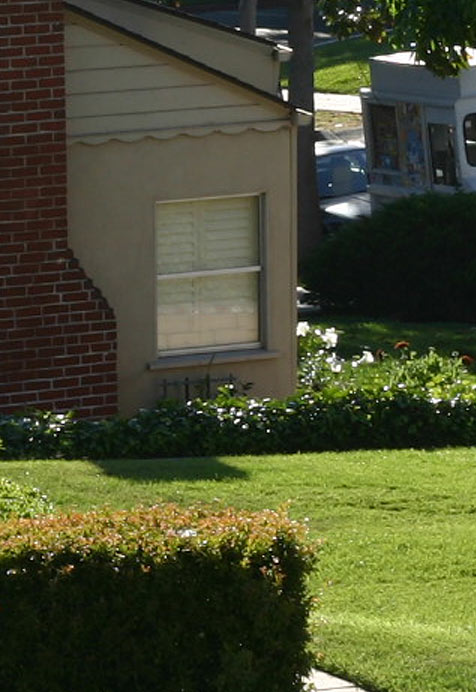 Lesson/Challenge/Puzzle Number One
Plus : A Small Deal
Lesson/Challenge/Puzzle Number One
Plus : A Small Deal
Let's revisit this with a special eye toward making the
most out of a compromised situation.
Here's the deal. In response to a question raised on DPReview,
I shot a contrasty scene with a prime lens (50mm f/1.8 Canon)
while the ISO, shutter and aperture were controlled manually.
A tripod furneshed stability and a string of shots were
made at Large and Medium size with both Fine and Normal compression
on each. No other changes to the camera were made other than
the image size and compression.
The smaller, Medium frame images were expanded to 150%
of their file size and laid on top of the full frame, Large shots,
registered and blinked on and off to see what the actual degree
of image loss was from each to the other three.
Actual file sizes were this (bytes):
Compression
>
Size v |
Fine |
Normal |
| Large (3072 x 2048) |
3,677,108 |
2,213,492 |
| Medium (2048 x 1364) |
2,150,358 |
1,377,126 |
No surprise: the Large / Fine image is the best in terms
of detail and lack of compression artifacts.
Next came Large / Normal with its more aggressive compression
but dead equal degree of detail.
The Medium frames suffered from the fact that they were
only 66.67% of the linear dimensions of the Large frames, and
when blown up to 3072 x 2048 and viewed at 100% scale on the
computer screen, they revealed their heritage as smaller file
sizes.
The Medium / Fine shot was nearly the same file size as
the Large / Normal image, making the slightly more detailed Large
/ Normal a better choice for improving the CF card's storage
space.
Which brings us to the Ultimate Test. Here are two shots
in the familiar rollover comparison format. One of them is the
Large / Fine slice and the other one was made at Medium / Normal.
Just to mess with your head, the Medium / Normal image was touched
by Photoshop with a sub-pixel "improvement" of 0.3
pixel x 100% Unsharp Masking to put back a smidge of extra apparent
detail.
Two questions:
- Which is which?
- How long did it take you to form this opinion?
 Perhaps a third question: did you get
the first one right? You should have, since the compression artifacts
are so visible. Look for a slightly grainy effect that seems
to hug areas of one flat tonality against lighter or darker flat
tonal areas.
Perhaps a third question: did you get
the first one right? You should have, since the compression artifacts
are so visible. Look for a slightly grainy effect that seems
to hug areas of one flat tonality against lighter or darker flat
tonal areas.
My feeling is that you could probably see the difference.
But perhaps not within 5 to 10 seconds. And if that were true,
then what does it say about the usefulness of the smaller file?
Remember, both of these would print the exact same size picture.
But the Medium / Normal image only consumed 37.5% of the memory
space the big one ate.
-iNova (May 30, 2004)
You may have to increase the font size of your browser
on your computer screen to read this, but here's the answer:
*The one with a nearby out of focus bug
visible against the mortar between the bricks in the chimney
is the shot taken at Medium/Normal.
 For
your Canon Digital Rebel- DSLR: Canon Digital Rebel EOS 300D
eBook is already on the shelf. DSLR: Canon Digital Rebel XT is
next. Then DSLR: Canon 20D follows. These are great cameras with
a great deal inside them, so we put a great deal of information
into their eBooks. You'll find things here that nobody else ever
told you about and not even Canon knew or could discuss.
For
your Canon Digital Rebel- DSLR: Canon Digital Rebel EOS 300D
eBook is already on the shelf. DSLR: Canon Digital Rebel XT is
next. Then DSLR: Canon 20D follows. These are great cameras with
a great deal inside them, so we put a great deal of information
into their eBooks. You'll find things here that nobody else ever
told you about and not even Canon knew or could discuss.
The existing
iNova eBooks, DSLR: Nikon D70 has become the most popular premium
eBook of all time. Mastering Nikon Compact Digital Cameras and
The SONY Advanced Cyber-shot eBook are also available. Click
on the image for the appropriate order page.